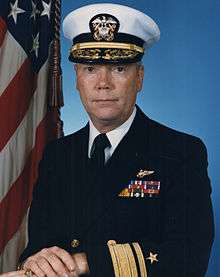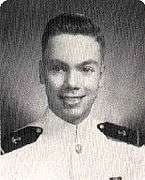Robert Harper Shumaker
| Robert H. Shumaker | |
|---|---|
 | |
| Nickname(s) | Bob |
| Born |
May 11, 1933 (age 83) New Castle, Pennsylvania, U.S. |
| Allegiance |
|
| Service/branch |
|
| Years of service | 1956–1988 |
| Rank |
|
| Commands held |
Project manager for Tactical missiles at Naval Air Systems Command Superintendent, Naval Postgraduate School |
| Battles/wars | Vietnam War |
| Awards |
Naval Distinguished Service Medal Silver Star (2) Legion of Merit with 'V' (3) Distinguished Flying Cross Bronze Star with "V" Navy Commendation Medal Purple Heart (2) Prisoner of War Medal |
Robert Harper Shumaker (born May 11, 1933) was a rear admiral and naval aviator in the United States Navy. He spent almost eight years as a prisoner of war (POW) in North Vietnam. He was notable in creating tap code, a common system of communication with POWs of Vietnam War and coining the term "Hanoi Hilton” for the notorious Hỏa Lò Prison.
Early life
Shumaker was born in May 11, 1933 at New Castle, Pennsylvania. His father Alvah was a lawyer and his mother Eleanor was a writer. He attended Northwestern University for a year and then the United States Naval Academy, graduating in 1956.[1]
Military career
After graduating from the U.S. Naval Academy, he then completed flight training, earning his designation as a Naval Aviator in January 1958. After flight training, Shumaker eventually joined VF-32, a fighter squadron in Jacksonville, Florida. He was a finalist in the Apollo astronaut selection, but a temporary physical ailment prevented his selection in 1963. He graduated from the U.S. Naval Postgraduate School with a master's degree in aeronautical engineering. Shumaker joined VF-154 in San Diego. About this time he married Lorraine Shaw.[2]
Vietnam War and capture
LCDR Shumaker was an F-8D pilot assigned to VF-154 on board the carrier USS Coral Sea. Shumaker's aircraft was shot down by 37mm cannon fire cannon fire on February 11, 1965 and his parachute opened a mere 35 feet from the ground. and he was captured by the North Vietnamese. The aircraft was destroyed. He was the second Navy aviator to be captured.The impact broke his back and he was placed in a jeep and transported over the rutted roads to Hanoi. Upon arrival in Hanoi, a white smocked North Vietnamese gave him a cursory examination before dozens of photographers yet did not give him any medical attention. His back healed itself, but it was six months before he could bend.[3] For the next 8 years, Shumaker was held in various prisoner of war camps,including the infamous Hỏa Lò Prison in Hanoi. Shumaker, in fact, dubbed this complex the "Hanoi Hilton". Shumaker, as a prisoner, was known for devising all sorts of communications systems,including the notable Tap code system and never getting caught. Like other POWs, he was badgered to write a request for amnesty from Ho Chi Minh,which he refused to do. As punishment, the Vietnamese forced Shumaker to stay in a cell with no heat and no blankets during the winter. After about a week, Shumaker had not relented, and it was forced to kneel for another week. Finally, he was kneeling on broom handles with boards on his shoulders. After a month the Vietnamese finally broke him and went on to the next POW.Shumaker was released in Operation Homecoming on February 12, 1973. He had been promoted to the rank of Commander during his captivity. His fellow POW's consider him as a resister, leader and patriot.[4]
Post-naval career
He was briefly hospitalized to recover from his injuries at Balboa Naval Hospital, from February to June 1973, and then attended the U.S. Naval Postgraduate School to complete his master's degree and PhD in Electrical Engineering from June 1973 to June 1977. RAdm Shumaker next served as a project manager for smart missiles with the Naval Air Systems Command at NAS Patuxent River, from June 1977 to June 1983, followed by service as superintendent of the Naval Postgraduate School from June 1983 to June 1986. His final assignment was as director of the Tactical Air, Surface & Electronic Warfare Development Division in the Office of the Chief of Naval Operations at the Pentagon from June 1986 until his retirement from the Navy on February 1, 1988.[5]
Later life
After retiring from the Navy, Shumaker became an assistant dean at George Washington University and later became the associate dean of the Center for Aerospace Sciences at the University of North Dakota.In April 2011 he was presented with the Distinguished Graduate Award from the United States Naval Academy[6]
Gallery
|
References
- ↑ http://www.navyhistory.org/2013/06/vietnam-pow-radm-robert-shumaker-leighton-lecture/
- ↑ http://www.navyhistory.org/2013/06/vietnam-pow-radm-robert-shumaker-leighton-lecture/
- ↑ http://www.ejection-history.org.uk/project/Biographies/S/Shumaker_Robert_Harper/schumaker_robert_harper.htm
- ↑ http://www.navyhistory.org/2013/06/vietnam-pow-radm-robert-shumaker-leighton-lecture/
- ↑ http://veterantributes.org/TributeDetail.php?recordID=143
- ↑ http://veterantributes.org/TributeDetail.php?recordID=143
